Collecting the Map Data
So having looked at the data suppliers lets take a look at how Tele Atlas gather their own data. The Tele Atlas European operation is run from Gent in Belgium. They have 22 mobile mapping vans which are kitted out with some great technology to capture and georeference the World.
Tele Atlas have a number of different vehicles to survey the roads. The famous one is the orange mapping van, but they also use some much smaller cars to get into some of the smaller streets in the centre of cities.
Click here for a short video showing the mapping van in action.
The mapping van that is used for most of the main surveying is a self-contained motor caravan (or RV if you are American) which has been modified to add the technology required to precisely digitise the country. Our demonstration mapping van was piloted by Belgians Stijn Ulenaers and Gudrun VanLaar, who, fortunately, are partners and live in the mapping van as well as work in it.
The mapping van has 2 computers that collect and store data, and up front on the passengers side is a tablet PC controlling the capture process. These are all networked together to complete the high tech mobile data collection system.
On the outside of the van are 6 digital cameras, as the mapping van is moving these are constantly snapping away taking pictures that have the GPS position embedded. These images are then saved to a pair of 250Gb hard disk drives.
The data capture rate is determined mainly by the weather conditions. On a bright sunny day the cameras can take pictures at speeds of up to 130KPH, but if the day is overcast or rainy the speeds are often dramatically reduced. To cope with the changing light the vans are scheduled to survey northern parts of the continent during the summer months and the southern areas during winter.
It takes about a week to fill a 250Gb disk drive. Once full one of the pair is sent to the Head office in Belgium by post. The other is saved as a backup in case of data corruption. If the disk arriving in Belgium is OK then surveying can continue. The captured data is then sent to the processing facility located in India. To date all the disks sent via mail have arrived safe and sound.
Although the vans are kitted out with GPS sometimes, as we all know, GPS doesn't work. A good example is when driving through tunnels. These obviously have to be mapped and mapped accurately so that underground junctions (such as in Basle, The Boston Big Dig, and the Limehouse Link) can be surveyed correctly. To accomplish this the van is fitted with sensors that can take over when the GPS signal has been lost. These measure distance traveled and turns, filling the gaps in the GPS tracklog.
Part of the management of the mapping vans is the planning of the areas to be surveyed. Numerous factors are taken into consideration such as the time of year, the known changes, the number of reported errors etc. This results in routes being created for the survey teams to drive. When looking at the vans in action the planned route is shown on the passenger's display as black lines, as the route is completed the black turns to green.
The operator of the tablet PC has 2 main responsibilities: providing navigation instructions to the driver, and checking the image quality that is being recorded. Stijn said that there were just two common problems: insects and picture contrast. Sometimes you have to scrape flies off the lens he explained.
The mapping van also has a fully fitted kitchen, sleeping quarters and washing facilities. This makes the van completely self contained eliminating the need to find lodgings, or even a camp site for the night.
Stijn and Gudrun along with the other 21 vans cover just under 2 million miles a year across Europe gathering the data that is improving the digital maps year on year. Allan Rasmussen of Tele Atlas says that around 20% of the map data is changed each year. Some of this is will be new developments and roads, whilst others will be a reclassification of road type, or change to one way street etc.
Once the data arrives in India there is a team of 800 operators who compare the images and tracks to the current mapping data extracting and referencing new information as it is located. This has resulted in the inclusion of signpost data in the mapping products which allow the solution providers to not only identify the road name, but also replicate the junction signpost in the navigation solution.
All of this information is consolidated into the master database. The master database is released to solution providers and mapping partners four times a year for inclusion in their latest products.
After taking in all this information we headed off home. This time it wasn't the simple straight motorway trip as there were 5 major incidents on the main roads. Fortunately I had my TMC enabled SatNav which routed me round the jams on pleasant country roads, even so it still took more than an hour extra for me to get home... |
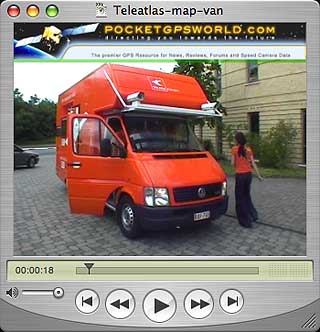
A short video showing the mapping van in action
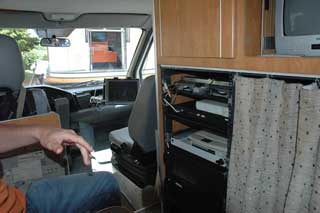 The technology hub in the mapping van The technology hub in the mapping van
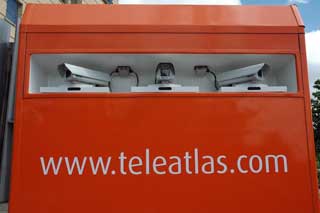
Big brother is watching you...
Six cameras are mounted on the van
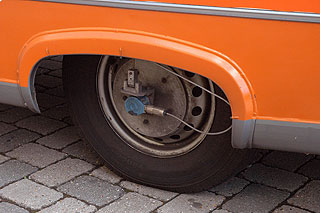
Sensors to compensate for the loss of GPS signal in tunnels
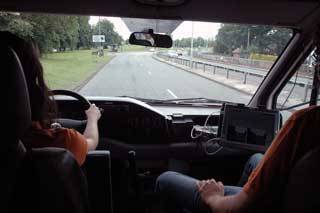
Surveying the roads around Reading
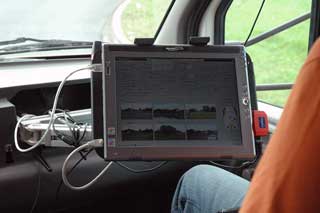
The tablet PC showing the images from the six onboard cameras. |